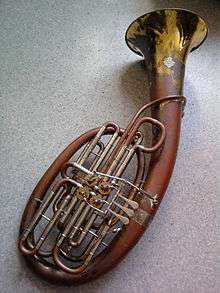Wagner tuba
|
Model 110 Double tuba in F/Bb
built by Gebr. Alexander Mainz. Rhein. Musikinstrumentenfabrik GmbH (Mainz, Germany). | |
| Brass instrument | |
|---|---|
| Other names |
en: Wagner tuba, de: Wagnertuba, it: Tuba wagneriana, fr: Tuba wagnérien |
| Classification | |
| Related instruments | |
| More articles | |
The Wagner tuba is an infrequently-used brass instrument that combines tonal elements of both the French horn and the trombone. Wagner tubas (or Wagnertuben) are also referred to as Wagner horns or Bayreuth tubas in English and as Bayreuth-Tuben or simply Tuben in German. The term Wagner tuba has been used in English since the 19th century and is standard today. Wagner's published scores usually refer to these instruments in the plural, Tuben, but sometimes in the singular, Tuba.
History
The Wagner tuba was originally created for Richard Wagner's operatic cycle Der Ring des Nibelungen. Since then, other composers have written for it, most notably Anton Bruckner, in whose Symphony No. 7 a quartet of them is first heard in the slow movement in memory of Wagner, and Richard Strauss, who composed several works that used the Wagner tuba, including his Alpine Symphony.
Wagner was inspired to invent the Wagner tuba after a brief visit to Paris in 1853 when he visited the shop of Adolphe Sax, the inventor of the saxophone and saxhorn. Wagner was initially shown a saxhorn which is similar to the instrument that Wagner ultimately wanted and later had constructed by the C. W. Moritz firm in Berlin. Wagner wanted an instrument that could produce the noble and sombre Valhalla motif in Das Rheingold like a trombone but with a less incisive tone, like that of a horn.
That Wagner tuba aural effect is obtained by a conical bore (like a horn) and the use of the horn mouthpiece (tapered and conical, as opposed to the parabolic cup mouthpiece such as on a trombone).[1] The saxhorn had a more cylindrical and larger bore, used the parabolic cupped mouthpiece, and thus had a more brassy tone that wasn't quite suitable for Wagner's tonal intent.
Design
The Wagner tuba is built with rotary valves, which (like those on the horn) are played with the left hand. Horn players traditionally double on Wagner tubas because the mouthpiece and fingering are identical.
The Wagner tuba nominally exists in two sizes, tenor in B-flat and bass in F, with ranges comparable to those of horns in the same pitches while being less adept at the highest notes. Several 20th-century and later manufacturers have, however, combined the two instruments into a double Wagner tuba that can easily be configured in either B-flat or F.
Wagner tubas are normally written as transposing instruments, but the notation used varies considerably and is a common source of confusion — Wagner himself used three different and incompatible notations in the course of the Ring, and all three of these systems (plus some others) have been used by subsequent composers.
An additional source of confusion is the fact that the instruments are invariably designated in orchestral scores simply as "tubas", leaving it sometimes unclear as to whether true bass tubas or Wagner tubas are intended (for example, the two tenor tubas in Janáček's Sinfonietta are sometimes wrongly assumed to be Wagner tubas when they are euphoniums).
The name "Wagner tuba" is considered problematic, possibly incorrect, by many theorists. Kent Kennan says they are poorly named since "they are really modified horns" rather than tubas.[2]
Impact
The sound of the Wagner tuba is as mellow as that of the horn and sounds more distant, yet also more focused. Anton Bruckner generally uses them for pensive melodic passages at piano to pianissimo dynamics. They can hold their own in a forte tutti, but Bruckner generally gives them sustained tones rather than melodic motifs in such passages.
In Bruckner's Eighth and Ninth Symphonies, the four Wagner tubas are played by players who alternate between horn and Wagner tuba, which is the same procedure Wagner used in the Ring. This change is simplified by the fact that the horn and Wagner tuba use the same mouthpiece and same fingering.
Where on the orchestral score the Wagner tubas are placed depend on who plays them.
The euphonium is often used as a substitute in modern orchestras, but the psychoacoustical difference between the two instruments is so substantial as to be noticeable.
In performance
Wagner tubas are typically played by players who are also playing a horn. The staves for the Wagner tubas logically go below those of the horns and above the standard tubas.
If they are played by players who are not also playing a horn, they are placed below the trombones, above the regular tuba, which is then called a "contrabass tuba."
These composers have written for the instrument:
- Béla Bartók
- Anton Bruckner
- Stephen Caudel
- Andrew Downes
- Felix Draeseke
- Jerry Goldsmith
- Sofia Gubaidulina
- Elisabeth Lutyens
- Michael Nyman
- Alexander Prior
- Einojuhani Rautavaara
- Esa-Pekka Salonen
- Arnold Schoenberg
- Ragnar Søderlind
- Richard Strauss
- Igor Stravinsky
- Edgard Varèse
- Richard Wagner
- Alec Wilder
- John Williams
References
External links
- The Wagner Tuba, history, composers and Edel Rhapsody (wagner-tuba.com)
- Felix Draeseke and the Wagner Tuba
- THE WAGNER TUBA – the instrument that only existed in Wagner’s imagination
- Wagner Tuba sound samples
- Evolution, Physics and Usage of the Wagner Tuba
